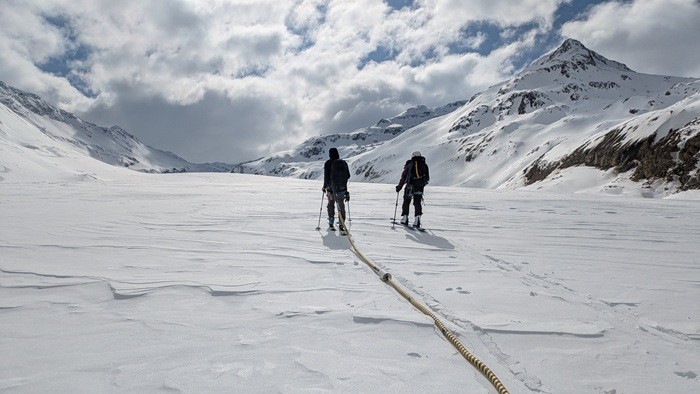For the fieldwork of the Junior Research Group “DeLIGHT Framework” this spring, we went to Hintereisferner in the Austrian Alps. We drove to Rofental on Tuesday and met up with colleagues from the Universität Innsbruck (UIBK). Together, we went to the small research station situated at 3,050 m a.s.l., which offers an excellent view of the impressive glacier. The hut was our home for the next three days and is equipped with a small gas stove, a table, eight beds, plenty of gumboots, a guitar, and an old portable gramophone. Upon arrival at the hut, we settled in, reviewed our crevasse-rescue techniques, and made the final preparations to go onto the glacier.
Over the following two days, our goal was to investigate the glacier and its subglacial water regime. We used a ground-penetrating radar (GPR) antenna provided by the Landslides working group at TUM. The GPR antenna sends out radar pulses and receives echoes from layers where the density changes. This makes GPR an ideal tool for detecting the bedrock beneath the ice, as well as objects or water within or beneath the ice.
After testing the antenna, we began our measurements on the lower part of the glacier. We skied across the glacier in a zigzag pattern while dragging the antenna behind us to obtain radar profiles perpendicular to the flow direction. We used a 50 MHz centre frequency for sufficient penetration depth in the ice and 100 MHz for high resolution of small features.
We were lucky with the weather on the second day and enjoyed some sunshine, which made the scenery magnificent. We could complete our measurements and ended up with a dense measurement grid of the lower part of the glacier. After finishing the data acquisition, we were able to relax and enjoy the cosy hut and its view on our third evening.
On Friday, we returned to civilisation, bringing with us a new dataset. With the collected data, we now have a record of the englacial water content in spring. Later this year - during the melt season - the measurements will be repeated, and the water content and discharge regime will be compared to the spring data. We are already looking forward to the next campaign.
Acknowledgements: We thank Felix Pfluger for his support in the field and for providing the GPR antennas. We also thank Léa Rodari for her assistance in the field. Our thanks further go to Rainer Prinz for the coordination, as well as to Marie Schroeder and Leo Schlagbauer for their hospitality at the research station.
Text: Céline Walker, Junior Research Group DeLIGHT Framework


